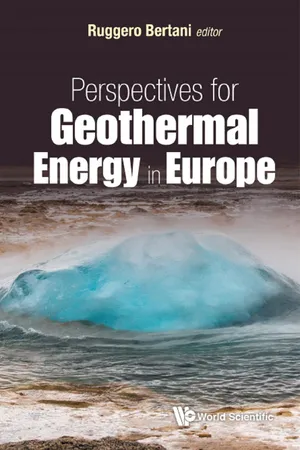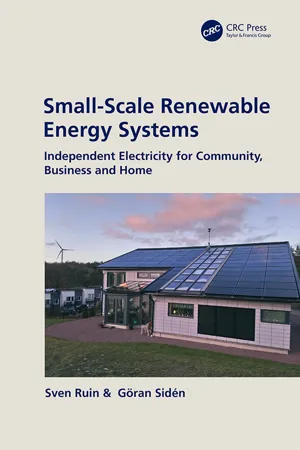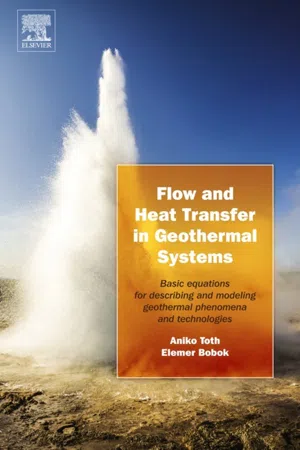Technology & Engineering
Binary Cycle
A binary cycle is a type of geothermal power plant that uses two different fluids to generate electricity. The first fluid is hot water or steam from the geothermal reservoir, which is used to heat a second fluid with a lower boiling point, such as isobutane or pentane. The second fluid then vaporizes and drives a turbine to generate electricity.
Written by Perlego with AI-assistance
Related key terms
4 Key excerpts on "Binary Cycle"
- eBook - ePub
- Ruggero Bertani(Author)
- 2017(Publication Date)
- WSPC (EUROPE)(Publisher)
Chapter 2Geothermal Binary Plants for European DevelopmentJoseph BonafinTurboden, via Cernaia 10 Brescia 25124, Italy [email protected]Geothermal projects are like fingerprints; each project is specific in its own way. This implies that some technical and economic prerequisites are required to understand the applicability of a power plant in a specific market.Binary technology makes the majority of geothermal sources exploitable, due to low-temperature applicability and flexibility. Organic Rankine Cycle (ORC) is the most widespread cycle for binary technology, with about 2 GW capacity installed and more than 500 projects in 80 countries currently under development. The ORC principle is very simple: it converts the geothermal heat into electricity into a closed process, with no harmful emissions.Geothermal power industry requires a multidisciplinary approach; in fact, many teams are involved in each phase of development: from geologist, to drilling experts, to geochemist, to the thermal and mechanical designer, to the financing partner.Once the project has reached the feasibility phase and at least one production well proved the resource, the project’s risk decreases and project financing is possible. The operation of a binary geothermal plant is eased by high reliability and low maintenance costs. Although a basic understanding of thermodynamics and heat transfer is required, the reader will be guided with simplified and practical approach to the binary power technology.2.1.The Organic Rankine Cycle (ORC) Cycle for Geothermal Applications2.1.1.Thermodynamics: PrinciplesIn binary plants, there is no direct use of geothermal fluid for electric power generation, but a secondary fluid (the binary one) is heated up and vaporized by means of heat exchange with the geothermal fluid, in order to spin a turbine and produce electricity.In geothermal power application, the general scheme is as follows (see Figure 2.1 - eBook - ePub
Small-Scale Renewable Energy Systems
Independent Electricity for Community, Business and Home
- Sven Ruin, Göran Sidén(Authors)
- 2019(Publication Date)
- CRC Press(Publisher)
Fig. 2.47 ). It differs from other types of geothermal power plants in that the flow from the source does not contact the turbine directly. The power plants use a secondary liquid with a lower boiling point, such as butane. The liquid evaporates when it is heated by the geothermal flow in a heat exchanger and the steam drives the turbine.Figure 2.46 Flash-steam plants are the most common type of geothermal power plant in operation today. Source: DOE/EIA [31]An advantage of this more complex system is that there are no emissions into the atmosphere, because the geothermal flow is occurring in a closed circuit.Figure 2.47 In a Binary Cycle power plant the heat from the rock is absorbed with a heat exchanger. Source: DOE/EIA [31]The disadvantages are that the geothermal stream must be kept under pressure so that it does not evaporate; it requires large flows and about 30% of the resulting electrical energy is consumed in the process.Although the achieved efficiency can be low – down to 10% – this type of geothermal power plant has the greatest potential for the future. This is because of the lower demands on temperature and purity of the source than a Binary Cycle plant needs.Although it is possible to work with temperatures lower than 100 °C, the efficiency of the electricity output decreases.Two types of cycles are used, Organic Rankine Cycle (most common) and Kalina cycle. The Rankine cycle is named after W. J. M. Rankine, a Scottish engineer and physicist. He was an important contributor to the science of thermodynamics. Rankine has developed a complete theory of the steam engine and indeed of all heat engines.The Organic Rankine Cycle (ORC) technology is one way to convert heat to electricity. Its main applications are electricity generation from renewable heat sources (geothermal, biomass, solar), but it can also be used for heat recovery from industrial processes. ORC systems can range in size from kilowatts for domestic cogeneration to large geothermal power plants. According to a report in 2017 [32] - eBook - ePub
- Tangellapalli Srinivas, N. Shankar Ganesh, R. Shankar(Authors)
- 2019(Publication Date)
- Apple Academic Press(Publisher)
Projections for future electricity demand are very uncertain because of the anticipated persistence of India’s dynamic development. Gross domestic product development, industry structure, population growth, and income levels are important drivers for energy and electricity demand. Growing energy demand and developing nonpolluting energy conversion systems are the probabilities to meet the challenges of energy crisis. A power cycle is an energy conversion system in which one form of energy is converted into another usable form. Power generation cycle is a set of repetitious processes that has the same starting and ending point in terms of state properties. It is difficult to erect the power plant without the thermodynamic design and the analysis.Kalina cycle configurations for low, intermediate, and high temperatures heat for power generation have been addressed in this book. In assessing a power cycle, the properties of the working fluid must be known. The properties of binary ammonia–water mixture have been developed for various pressures, temperatures, and concentrations. In determining the properties of the working fluid, computer codes in MATLAB have been prepared. These property codes works as a function program in the main program of the Kalina systems. At given values of temperature, pressure, and concentration, the property data for enthalpy, entropy, volume, and exergy have been developed. Using mass, energy, and exergy balances, the performance of the KCS has been evaluated at Indian atmospheric conditions.The binary working fluid method is complicated compared to pure substance as it involves the function of pressure, temperature, and concentration. The current chapter simplifies this complex nature of method and analyzes the basic processes for power generation solutions.The methodology for KCS at low-temperature heat recovery has been simplified and developed at efficient operational conditions. The regular design of serially connected high-temperature regenerator and boiler in a KCS has been replaced with parallel heaters and compared with each other. The influence of strong solution concentration, vapor concentration, source temperature, and effectiveness of dephlegmator is studied on performance of the plant. The key parameters are optimized to get a high performance. - eBook - ePub
Flow and Heat Transfer in Geothermal Systems
Basic Equations for Describing and Modeling Geothermal Phenomena and Technologies
- Aniko Toth, Elemer Bobok(Authors)
- 2016(Publication Date)
- Elsevier(Publisher)
Chapter 11Geothermal Power Generation
Abstract
Several changes of the state of wet steam are studied and represented on the T–s (temperature–entropy) diagram. The archetype of all power cycles is the Clausius–Rankine cycle. The energy conversion from thermal to mechanical energy occurs in the steam turbines. Different types of geothermal power plants are introduced; single flash, dry steam, and binary plants.Keywords
Binary Cycle; Change of state of wet steam; Dry steam cycle; Flash cycle; Steam turbines; T–s diagram; Velocity triangles; Working cycleOutline11.1 Change of State of Wet Steam 11.2 The Clausius–Rankine Cycle 11.3 Steam Turbines 11.4 Geothermal Power Plants 11.4.1 Single Flash Steam Power Plants 11.4.2 Dry-Steam Power Plants 11.4.3 Binary Cycle Power Plants References11.1. Change of State of Wet Steam
The law of conservation and conversion of energy is the fundamental general law of nature. This law states that energy does not vanish nor appear anew, it only passes from one form of energy into another through various physical and chemical processes. Geothermal energy is produced as the enthalpy content of the recovered reservoir fluids. The conversion of heat into work is realized in steam power cycles. The distinguishing feature of steam power cycles is that the state of aggregation of the working medium used in the cycle changes from liquid to a two-phase mixture (wet steam), then to superheated steam. The state of superheated steam is usually so close to the saturation region that the laws for an ideal gas are not applicable. In general, it is not possible to express the equation of state in a simple analytic form. It can be tabulated or plotted against the variables of state. It is obvious that an equation such as:p = p( V,T )can be represented by a surface in the coordinate system p,V,T. This surface of state consists of piecewise continuous surface parts as shown in Fig. 11.1
Index pages curate the most relevant extracts from our library of academic textbooks. They’ve been created using an in-house natural language model (NLM), each adding context and meaning to key research topics.



